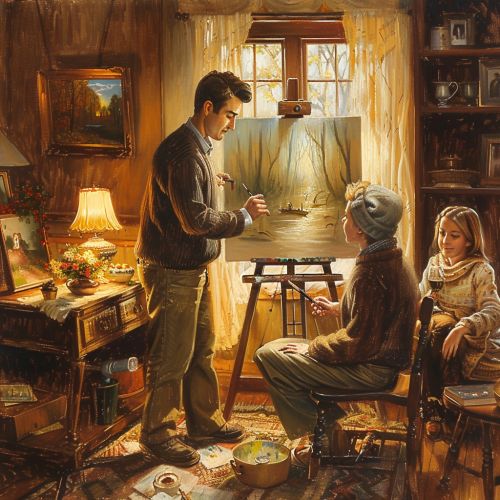The Mother and Sister of the Artist: Difference between revisions
No edit summary |
No edit summary |
||
| Line 7: | Line 7: | ||
Throughout history, the mother and sister of an artist have often been pivotal figures in their lives. In many cases, these family members have served as muses, caretakers, and emotional anchors. For instance, [[Vincent van Gogh]]'s relationship with his mother and sister was complex and deeply influential. Van Gogh's mother, Anna Cornelia Carbentus, was a strict and religious woman, which contrasted sharply with Vincent's rebellious and passionate nature. His sister, Wilhelmina Jacoba van Gogh, known as Wil, was one of his closest confidantes, and their correspondence provides valuable insights into his personal struggles and artistic development. | Throughout history, the mother and sister of an artist have often been pivotal figures in their lives. In many cases, these family members have served as muses, caretakers, and emotional anchors. For instance, [[Vincent van Gogh]]'s relationship with his mother and sister was complex and deeply influential. Van Gogh's mother, Anna Cornelia Carbentus, was a strict and religious woman, which contrasted sharply with Vincent's rebellious and passionate nature. His sister, Wilhelmina Jacoba van Gogh, known as Wil, was one of his closest confidantes, and their correspondence provides valuable insights into his personal struggles and artistic development. | ||
[[Image:Detail-96159.jpg|thumb|center|An artist working on a painting with his mother and sister observing in a cozy, well-lit room.]] | [[Image:Detail-96159.jpg|thumb|center|An artist working on a painting with his mother and sister observing in a cozy, well-lit room.|class=only_on_mobile]] | ||
[[Image:Detail-96160.jpg|thumb|center|An artist working on a painting with his mother and sister observing in a cozy, well-lit room.|class=only_on_desktop]] | |||
=== Psychological Influence === | === Psychological Influence === | ||
Latest revision as of 09:33, 4 July 2024
The Mother and Sister of the Artist
The relationship between an artist and their family, particularly their mother and sister, often plays a significant role in shaping their artistic journey and output. This article delves into the intricate dynamics and influences that the mother and sister of an artist can have on their work, exploring historical examples, psychological aspects, and sociocultural contexts.
Historical Context
Throughout history, the mother and sister of an artist have often been pivotal figures in their lives. In many cases, these family members have served as muses, caretakers, and emotional anchors. For instance, Vincent van Gogh's relationship with his mother and sister was complex and deeply influential. Van Gogh's mother, Anna Cornelia Carbentus, was a strict and religious woman, which contrasted sharply with Vincent's rebellious and passionate nature. His sister, Wilhelmina Jacoba van Gogh, known as Wil, was one of his closest confidantes, and their correspondence provides valuable insights into his personal struggles and artistic development.


Psychological Influence
The psychological impact of an artist's mother and sister can be profound. Theories in psychoanalysis suggest that early childhood experiences with primary caregivers, often the mother, shape an individual's emotional and psychological development. For artists, these early relationships can influence their creative expression and thematic choices. The Oedipus complex, as proposed by Sigmund Freud, highlights the significance of the mother in the psychological development of an individual, which can manifest in various forms in an artist's work.
The sister's role, often as a peer and confidante, can also be significant. Sibling rivalry, support, and shared experiences contribute to an artist's emotional landscape. For example, the relationship between James Abbott McNeill Whistler and his sister, Deborah, was marked by both competition and deep affection, which influenced Whistler's artistic style and subject matter.
Sociocultural Context
The sociocultural context in which an artist is raised also plays a crucial role in shaping their relationship with their mother and sister. In many cultures, the mother is seen as the primary nurturer and moral guide, while the sister often takes on roles that range from caretaker to competitor. These roles are deeply embedded in societal norms and expectations, which can either support or hinder an artist's development.
In the case of Pablo Picasso, his mother, María Picasso y López, was a significant influence in his early life, encouraging his artistic talents. Picasso's sister, Lola, also played a crucial role, often modeling for his early works and providing emotional support. The strong familial bonds and cultural values of their Spanish heritage were evident in Picasso's work throughout his career.
Artistic Representation
Artists often depict their mothers and sisters in their works, either directly or symbolically. These representations can provide insights into the artist's personal life and emotional state. For instance, Gustav Klimt frequently portrayed his sister, Klara, in his paintings, reflecting their close relationship and her influence on his artistic vision.
Similarly, Edvard Munch's famous painting, "The Sick Child," is a poignant representation of his sister, Sophie, who died of tuberculosis. This work not only reflects Munch's personal grief but also explores themes of illness, mortality, and familial bonds.
Case Studies
Vincent van Gogh
Vincent van Gogh's tumultuous relationship with his mother and sister is well-documented through his letters. His mother's disapproval of his unconventional lifestyle and career choices created a strained relationship. However, his sister Wil provided a source of emotional support and understanding. Van Gogh's letters to Wil reveal his deep-seated need for familial acceptance and his struggles with mental illness.
James Abbott McNeill Whistler
Whistler's relationship with his sister, Deborah, was multifaceted. Deborah's early death had a profound impact on Whistler, influencing his melancholic and introspective artistic style. His famous painting, "Arrangement in Grey and Black No.1," commonly known as "Whistler's Mother," is a tribute to his mother, Anna McNeill Whistler, and reflects the deep bond they shared.
Pablo Picasso
Picasso's mother and sister were central figures in his early life. His mother's encouragement and his sister's support were instrumental in his artistic development. Picasso's Blue Period, characterized by somber tones and themes of poverty and despair, was influenced by the death of his sister, Conchita, which left a lasting impact on his psyche and work.
Conclusion
The mother and sister of an artist often play crucial roles in their personal and professional lives. Their influence can be seen in the artist's psychological development, sociocultural context, and artistic representation. By examining historical examples and case studies, we gain a deeper understanding of the complex dynamics that shape an artist's work and legacy.
